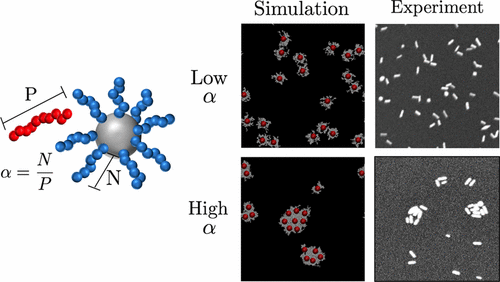当前位置:
X-MOL 学术
›
Macromolecules
›
论文详情
Our official English website, www.x-mol.net, welcomes your
feedback! (Note: you will need to create a separate account there.)
Comparison of Field-Theoretic Approaches in Predicting Polymer Nanocomposite Phase Behavior
Macromolecules ( IF 5.1 ) Pub Date : 2017-11-02 00:00:00 , DOI: 10.1021/acs.macromol.7b01731 Jason P. Koski 1 , Robert C. Ferrier , Nadia M. Krook , Huikuan Chao , Russell J. Composto , Amalie L. Frischknecht 1 , Robert A. Riggleman
Macromolecules ( IF 5.1 ) Pub Date : 2017-11-02 00:00:00 , DOI: 10.1021/acs.macromol.7b01731 Jason P. Koski 1 , Robert C. Ferrier , Nadia M. Krook , Huikuan Chao , Russell J. Composto , Amalie L. Frischknecht 1 , Robert A. Riggleman
Affiliation

|
Because of the considerable parameter space, efficient theoretical and simulation methods are required to predict the morphology and guide experiments in polymer nanocomposites (PNCs). Unfortunately, theoretical and simulation methods are restricted in their ability to accurately map to experiments based on necessary approximations and numerical limitations. In this study, we provide direct comparisons of two recently developed coarse-grained approaches for modeling polymer nanocomposites (PNCs): polymer nanocomposite field theory (PNC-FT) and dynamic mean-field theory (DMFT). These methods are uniquely suited to efficiently capture mesoscale phase behavior of PNCs in comparison to other theoretical and simulation frameworks. We demonstrate the ability of both methods to capture macrophase separation and describe the thermodynamics of PNCs. We systematically test how the nanoparticle morphology in PNCs is affected by a uniform probability distribution of grafting sites, common in field-based methods, versus random discrete grafting sites on the nanoparticle surface. We also analyze the accuracy of the mean-field approximation in capturing the phase behavior of PNCs. Moreover, the DMFT method introduces the ability to describe nonequilibrium phase behavior while the PNC-FT method is strictly an equilibrium method. With the DMFT method we are able to show the evolution of nonequilibrium states toward their equilibrium state and a qualitative assessment of the dynamics in these systems. These simulations are compared to experiments consisting of polystyrene grafted gold nanorods in a poly(methyl methacrylate) matrix to ensure the model gives results that qualitatively agree with the experiments. This study reveals that nanoparticles in a relatively high matrix molecular weight are trapped in a nonequilibrium state and demonstrates the utility of the DMFT framework in capturing nonequilibrium phase behavior of PNCs. Both the PNC-FT and DMFT framework are promising methods to describe the thermodynamic and nonequilibrium phase behavior of PNCs.
中文翻译:

场理论方法在预测聚合物纳米复合相行为中的比较
由于大量的参数空间,需要有效的理论和模拟方法来预测聚合物纳米复合材料(PNC)的形貌并指导实验。不幸的是,理论和模拟方法在根据必要的近似值和数值限制准确映射到实验的能力方面受到限制。在这项研究中,我们直接比较了两种最近开发的用于对聚合物纳米复合材料(PNC)进行建模的粗粒度方法:聚合物纳米复合材料场理论(PNC-FT)和动态平均场理论(DMFT)。与其他理论和仿真框架相比,这些方法特别适合于有效捕获PNC的中尺度相位行为。我们证明了这两种方法捕获宏观相分离的能力,并描述了PNC的热力学。我们系统地测试了PNC中的纳米颗粒形态如何受到基于场的方法中普遍存在的接枝位点相对于纳米颗粒表面上随机离散的接枝位点的均匀概率分布的影响。我们还分析了捕获PNC的相位行为时平均场近似的准确性。此外,DMFT方法引入了描述非平衡相行为的能力,而PNC-FT方法严格来说是一种平衡方法。使用DMFT方法,我们可以显示非平衡态向其平衡态的演化,并可以对这些系统中的动力学进行定性评估。将这些模拟与由聚甲基丙烯酸甲酯基体中的聚苯乙烯接枝金纳米棒组成的实验进行比较,以确保模型给出的结果与实验定性一致。这项研究表明,相对较高的基质分子量的纳米颗粒被困在非平衡状态,并证明了DMFT框架在捕获PNC的非平衡相行为中的实用性。PNC-FT和DMFT框架都是描述PNC的热力学和非平衡相行为的有前途的方法。
更新日期:2017-11-02
中文翻译:

场理论方法在预测聚合物纳米复合相行为中的比较
由于大量的参数空间,需要有效的理论和模拟方法来预测聚合物纳米复合材料(PNC)的形貌并指导实验。不幸的是,理论和模拟方法在根据必要的近似值和数值限制准确映射到实验的能力方面受到限制。在这项研究中,我们直接比较了两种最近开发的用于对聚合物纳米复合材料(PNC)进行建模的粗粒度方法:聚合物纳米复合材料场理论(PNC-FT)和动态平均场理论(DMFT)。与其他理论和仿真框架相比,这些方法特别适合于有效捕获PNC的中尺度相位行为。我们证明了这两种方法捕获宏观相分离的能力,并描述了PNC的热力学。我们系统地测试了PNC中的纳米颗粒形态如何受到基于场的方法中普遍存在的接枝位点相对于纳米颗粒表面上随机离散的接枝位点的均匀概率分布的影响。我们还分析了捕获PNC的相位行为时平均场近似的准确性。此外,DMFT方法引入了描述非平衡相行为的能力,而PNC-FT方法严格来说是一种平衡方法。使用DMFT方法,我们可以显示非平衡态向其平衡态的演化,并可以对这些系统中的动力学进行定性评估。将这些模拟与由聚甲基丙烯酸甲酯基体中的聚苯乙烯接枝金纳米棒组成的实验进行比较,以确保模型给出的结果与实验定性一致。这项研究表明,相对较高的基质分子量的纳米颗粒被困在非平衡状态,并证明了DMFT框架在捕获PNC的非平衡相行为中的实用性。PNC-FT和DMFT框架都是描述PNC的热力学和非平衡相行为的有前途的方法。











































 京公网安备 11010802027423号
京公网安备 11010802027423号